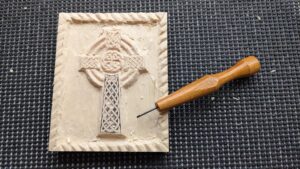Back in 2016, I started eating one meal a day (OMAD.) This was something I came to very slowly, over the course of sixteen months of practicing intermittent fasting. I was doing this to lose weight (80 pounds total), and it worked. Read my book, The Laid Back Guide to Intermittent Fasting, if you want more of the nitty-gritty details. Fast forward eight years to today, and I still eat this way. This simple way of eating helps me keep the weight off with what feels like very little effort.
Many people like the idea of OMAD, but they’ve never been around someone who practices it. So, I thought it might be helpful to give you a glimpse into what a typical day in my life looks like. One of the challenges of OMAD is that you have a long stretch of time where eating is not an option. This is how I fill the void.
Rising From Sleep (4 or 5 AM)
I usually wake up before my husband, without an alarm. I get up, go to the bathroom, and then weigh myself. I put that weight in my weight-tracking app. I was not always an early riser. This is a habit I got into in 2015 when I was obese and trying desperately to lose weight. I joined a gym, and the only way I could mentally allow myself this luxury was to get myself up at 4, go work out, and be back home before my kids were awake. I eventually ditched the gym membership, but I kept the habit of waking up early. Being up early means I have some silence in my day before the rest of my household rises. I’m a mom, and I get asked a lot of questions. They range in age from 12 to 18, and I think they have more questions now than they did when they were smaller. Questions and other interruptions come with the job. I love it, and I want to give them my undivided attention when they need it. I also have projects that are important to me that I need to work on without being interrupted. The ideal time to do this is early in the morning.

I pour myself a cup of coffee, which I enjoy as I read four chapters of the Bible plus one chapter from the Gospels. Then I go to our prayer corner and say my morning prayers. After that, I journal, similar to the 5-minute journal format. Then I do the Wordle, Strands, and Connections. I post my results inside my family’s Google chat. That done, I take a post-it note and jot down a to-do list.
The Meat of My Day (6 AM – 5 PM)
The first task is to write 1,000 words. If I do not sit down and write at this point, it won’t get done. Depending on the day, this might take 40 minutes or an hour. Sometimes it takes even longer. At 7 AM, my family says Matins. This is a morning prayer service taken from the Divine Office that includes singing hymns, reading certain Psalms, and lessons from the Bible. It takes about 25 minutes.
After Matins, I finish up my thousand words. If there are some quick tasks I can knock out, I do that. When I notice that I’m starting to lose focus, I get up and start walking. I walk six miles a day, which takes a couple of hours. While I’m walking, I’m often mentally working. I’m writing in my head, thinking about plot lines or better ways to explain things, or I’m rehearsing things I’ll say on my next video or podcast. When my brain feels tired, I switch to YouTube and watch videos about things I want to learn, or I’ll listen to a podcast. Occasionally I’ll read a book while walking, but this is my least favorite way to walk and my least favorite way to read.
After an hour or so, I feel like doing more sitting work, so I’ll tackle my to-do list. As a homeschooling mom of three who works from home, this runs the gamut. Reconciling my checkbook and checking our budget, recording a new YouTube video, writing a book, editing (videos, my writing), writing my newsletter, figuring out supper, and making a grocery list are a few examples of what might be done during this time. I usually grab some more coffee with half and half as I work.
After a couple of hours, I feel sore from sitting in one position for so long, so I get up and walk around some more. This is generally around noon. I’ll likely have an hour of walking left, and since my brain will be feeling a bit fried, I’ll focus on finishing my step goal.
Then comes some reading time. I have a goal to read 52 books a year (another good habit that came out of 2015). I lie down on my couch and read, because that’s pretty much the only thing I can get myself to do in the early afternoon. Sometimes I’ll nod off while reading. Many times I get interrupted by my kids asking questions or sharing things with me, which I love. Too soon they’ll all be grown up, out of the house, and I’ll have long stretches of time where no one interrupts my reading. I’m going to savor those interruptions now.
OMAD Prep and Eating (4-6PM)
At around 4 or so, it’s time to start prepping for supper, my one meal of the day. I’m good and hungry by this time, but it’s not an unbearable or even inconvenient kind of hunger. I’m just ready to eat. I do not count calories or limit carbs. We sit down to the table, and I simply eat until I’m full. Last night, I ate half of a sausage, onion, and garlic pizza. I wasn’t full after I ate half the pizza, so I had a simple dessert of a spoonful of peanut butter covered with chocolate chips.
Evenings (6 PM-8 PM)

After supper, it’s free time. Sometimes I putter around the yard, other times I just hang out with the family, and sometimes they’re working on other projects, so I sit and read more. Other times, I carve some wood. At 7:30, it’s time for Vespers, an evening prayer service that has a similar structure to matins. And then we say good night and I go to bed. I generally fall asleep fast and sleep soundly until I wake up at four or so. And then this cycle repeats.
The key to practicing OMAD consistently is staying busy. If you want to implement this in your life, be sure to have plenty of tasks at hand to you that you enjoy, or that are difficult, but that you find meaning in. Otherwise, eating will win out in the end.
